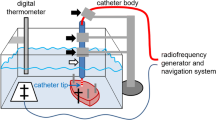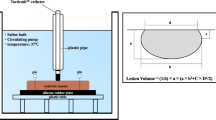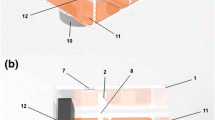Abstract
Purpose
Cardiac perforation (CP) is an uncommon but clinically important complication of radiofrequency ablation (RFA). We previously showed that contact-force recovery after a steam pop predicts the absence of CP in an open-chest animal model after pericardial dissection. We attempted to determine whether this also applies when pericardium is present.
Methods
In 5 open-chest sheep, left atrial RFA was performed under direct observation with a 7.5F ThermoCool SmartTouch force-sensing catheter (Biosense Webster Inc., Irvine, CA, USA). The catheter’s contact force was measured every 50 ms during RFA. After each steam pop, the presence (+) or absence (−) of CP was noted, as well as whether pericardium was present over the ablation site. Contact-force signals were analyzed to detect contact-force recovery. Perforation rates were compared between sites with or without pericardium.
Results
Ninety-six steam pops occurred: 77 with pericardium and 19 without. For the pericardial steam pops, contact-force recovery occurred in 31/60 CP− events (52%) and 1/17 CP+ events (6%; P = 0.0006). For nonpericardial steam pops, contact-force recovery occurred in 4/9 CP− events (44%) and 1/10 CP+ events (P = 0.14). The rate of CP was 22% with pericardium and 52% without (P = 0.02). Pericardial tissue charred extensively during steam pop induction, even in the absence of CP.
Conclusions
Contact-force recovery predicts the absence of CP during RFA independently of whether the pericardium is present. The presence of the pericardium may decrease the likelihood of perforation, perhaps by acting as a thermal sink. Additional studies are needed to correlate these results with clinical experience.



Similar content being viewed by others
References
Chik WW, Kosobrodov R, Bhaskaran A, Barry MA, Nguyen DT, Pouliopoulos J, et al. Acoustic signal emission monitoring as a novel method to predict steam pops during radiofrequency ablation: preliminary observations. J Cardiovasc Electrophysiol. 2015;26:440–7.
Eick OJ, Gerritse B, Schumacher B. Popping phenomena in temperature-controlled radiofrequency ablation: when and why do they occur? Pacing Clin Electrophysiol. 2000;23:253–8.
Nazeri A, Ganapathy A, Massumi A, Massumi M, Constantine G, Raz S, et al. Contact-force recovery can predict cardiac perforation during radiofrequency ablation. Pacing Clin Electrophysiol. 2014;37:1129–32.
Go AS, Hylek EM, Phillips KA, Chang Y, Henault LE, Selby JV, et al. Prevalence of diagnosed atrial fibrillation in adults: national implications for rhythm management and stroke prevention: the AnTicoagulation and Risk Factors in Atrial Fibrillation (ATRIA) Study. JAMA. 2001;285:2370–5.
Khairallah F, Ezzedine R, Ganz LI, London B, Saba S. Epidemiology and determinants of outcome of admissions for atrial fibrillation in the United States from 1996 to 2001. Am J Cardiol. 2004;94:500–4.
Tung R, Buch E, Shivkumar K. Catheter ablation of atrial fibrillation. Circulation. 2012;126:223–9.
Tokuda M, Kojodjojo P, Epstein LM, Koplan BA, Michaud GF, Tedrow UB, et al. Outcomes of cardiac perforation complicating catheter ablation of ventricular arrhythmias. Circ Arrhythm Electrophysiol. 2011;4:660–6.
Koruth JS, Dukkipati S, Gangireddy S, McCarthy J, Spencer D, Weinberg AD, et al. Occurrence of steam pops during irrigated RF ablation: novel insights from microwave radiometry. J Cardiovasc Electrophysiol. 2013;24:1271–7.
Ikeda A, Nakagawa H, Lambert H, Shah DC, Fonck E, Yulzari A, et al. Relationship between catheter contact force and radiofrequency lesion size and incidence of steam pop in the beating canine heart: electrogram amplitude, impedance, and electrode temperature are poor predictors of electrode-tissue contact force and lesion size. Circ Arrhythm Electrophysiol. 2014;7:1174–80.
Theis C, Rostock T, Mollnau H, Sonnenschein S, Himmrich E, Kampfner D, et al. The incidence of audible steam pops is increased and unpredictable with the ThermoCool(R) Surround Flow catheter during left atrial catheter ablation: a prospective observational study. J Cardiovasc Electrophysiol. 2015;26:956–62.
Funding
This study was funded by a research grant from Biosense Webster.
Author information
Authors and Affiliations
Corresponding author
Ethics declarations
Study approval was obtained from our Institutional Committee on Animal Use and Care, and the study protocol conformed to the Guide for the Care and Use of Laboratory Animals guidelines.
Conflict of interest
The authors declare that they have no conflict of interest.
Additional information
Publisher’s note
Springer Nature remains neutral with regard to jurisdictional claims in published maps and institutional affiliations.
Rights and permissions
About this article
Cite this article
Ganapathy, A.V., Nazeri, A., Ashton, J. et al. Contact-force recovery predicts the absence of cardiac perforation during steam pops. J Interv Card Electrophysiol 61, 181–186 (2021). https://doi.org/10.1007/s10840-020-00794-y
Received:
Accepted:
Published:
Issue Date:
DOI: https://doi.org/10.1007/s10840-020-00794-y




